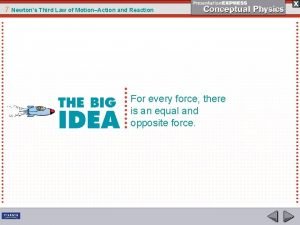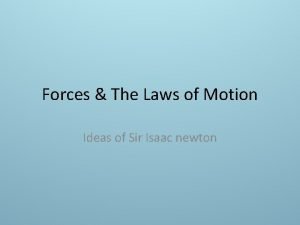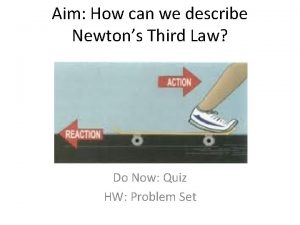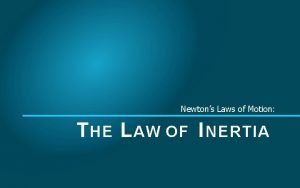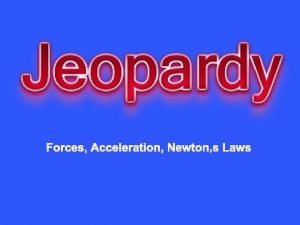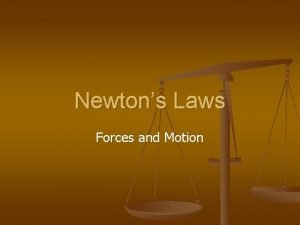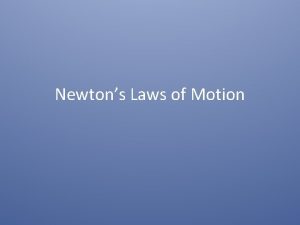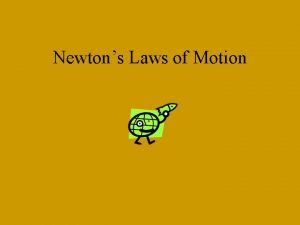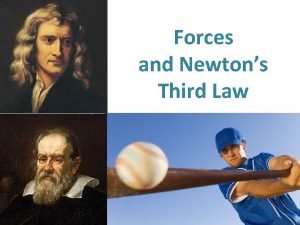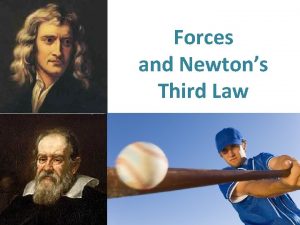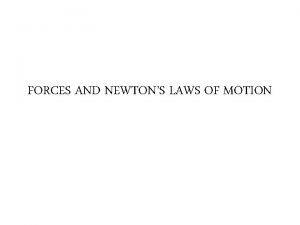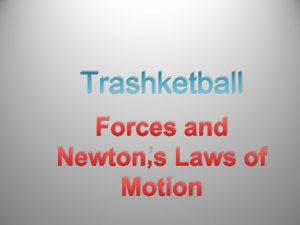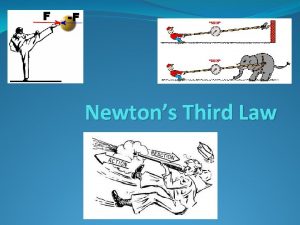Forces and Newtons Laws of Motion Newtons Third















- Slides: 15

Forces and Newton’s Laws of Motion Newton’s Third Law and Friction

What We Want to Know… n n What is Newton’s Third Law of Motion? What does action-reaction pairs mean forces? Where does Newton’s Third Law affect everyday life? How does friction affect motion?

Newton’s Third Law of Motion n The law of action and reaction. “For every action, there is an equal and opposite reaction. ” Forces always exist in pairs called “actionreaction pairs. ” q When two objects interact they exert forces on one another that are equal and opposite.

n n Action-reaction pairs do not cancel each other out. Each force acts on a different object.

Examples?

Friction n Frictional force resists applied forces. Friction always resists motion (parallel to the surface). Two types of friction: q q Static: the resistive force of a non-moving object. Kinetic Friction: the resistive force of a moving object. Weaker than static.

Coefficient of Friction n Coefficient of friction (μ): friction’s dependence on type of surface. It is a ratio of frictional force over normal force.

Coefficients of Friction Surface steel on steel (dry) steel on steel (greasy) ice on ice rubber on wood rubber on concrete (dry) rubber on concrete (wet) μs. 74. 1. 1. 7 1. 0. 3 μk. 57. 05. 03. 8. 25

Coefficient of Friction n n What force is required to push a 25 kg box across a floor at a constant rate if μk=. 6? A person pulls a 40 kg bag across a floor with μk=. 3. What is the net force if the bag is pulled with a force of 150 N straight to the side?

Practice n A 35 kg bed is pulled by some unknown force across the floor. If the bed accelerates at 4. 0 m/s², with only friction opposing it, what is the magnitude of the pulling force? (µ=. 14)

A Little Review n What are the two types of forces? q n What is weight and how is it different from mass? q n Contact and Field Forces Weight is the force of gravity which changes on location. Mass is the matter in an object which stays the same. What is inertia? q An object’s resistance to a change in motion.

A Little Review n What is Newton’s 1 st Law of Motion? q n What is ΣF? q n Objects keep the same motion unless acted upon by an unbalanced force. Net force = the sum of your forces in a certain direction (x or y) When is an object in equilibrium? q ΣF = 0, object stays at rest, object has constant velocity (no acceleration).

A Little Review n What is Newton’s 2 nd Law of Motion? q n What is Newton’s 3 rd Law of Motion? q n ΣF = ma. Acceleration is proportional to force and inversely proportional to mass Every action has an equal and opposite reaction. What are the two types of friction? q Static and kinetic friction.

S. T. A. M. P. n A 12 kg sled is pulled across the snow with a force of 30 N. If the force is applied at an angle of 30˚ above the +x-axis (µ =. 13): a) b) c) d) e) Draw a free-body diagram Find the x and y components of the applied force Calculate the normal force Calculate the frictional force Calculate the acceleration of the sled

Physics Test Practice 1. A student pulls on a 5 kg desk with a force of 40 N at an angle of 20˚ above the horizontal. If the desk does not move, what is the force of friction? What is the normal force? 2. A 140 kg car accelerates straight along the positive x-direction. If the car accelerates at 12 m/s², what is the force of the car’s acceleration. (µ=. 4)
 Chapter 8 ask newton
Chapter 8 ask newton Newton's 3 laws of motion
Newton's 3 laws of motion Newton's 3 laws of motion
Newton's 3 laws of motion Colin skateboards down the sidewalk
Colin skateboards down the sidewalk Section 2 newtons laws of motion
Section 2 newtons laws of motion Law of newton 3
Law of newton 3 What are newton's three laws
What are newton's three laws Forces and the laws of motion problem b
Forces and the laws of motion problem b Describe newtons third law
Describe newtons third law Newton's third law of thermodynamics
Newton's third law of thermodynamics Newtons law
Newtons law Newtons third aw
Newtons third aw Facts about newtons laws
Facts about newtons laws Fg physics formula
Fg physics formula Newton's 3 laws
Newton's 3 laws Third law of newton
Third law of newton

